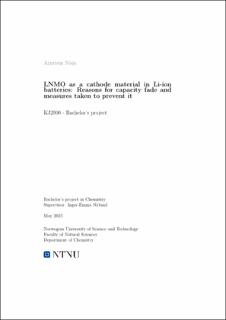| dc.contributor.advisor | Nylund, Inger-Emma | |
| dc.contributor.author | Nisja, Arnstein | |
| dc.date.accessioned | 2023-06-18T17:19:36Z | |
| dc.date.available | 2023-06-18T17:19:36Z | |
| dc.date.issued | 2023 | |
| dc.identifier | no.ntnu:inspera:146699659:66002910 | |
| dc.identifier.uri | https://hdl.handle.net/11250/3071932 | |
| dc.description.abstract | Lithium nikkel manganoksid (LNMO) er en lovende kandidat som katodemateriale i Li-ion batterier (LIBs) på grunn av sin høye energitetthet. Batterier med LNMO som katodemateriale kan oppleve kapsitetstap over tid grunnet strukturelle og kjemiske nedbrytninger som oppstår, samt dannelse av ulike grenseflater med elektrolytten. Nedbrytningsmekanismene til LNMO studeres intensivt for å kunne forbedre ytelsen og påliteligheten til disse batteriene. Noen av strategiene er beskyttende belegg for å redusere strukturell nedbrytning, modifikasjoner av elektrodesammensetning for å forbedre stabiliteten til LNMO, og valg av egnet elektrolytt for LNMOs høye cellepotensial på 4,7 V. Optimalisering av batteridesignet for å redusere dannelse av katode-elektrolytt grenseflate (KEG) og faststoff-elektrolytt grenseflate (FEG) lag på overflaten av LNMO blir forsket på som et mottiltak for kapasitetstap. Ved bruk av tilsetningstoffer som glyceryl triacetate (GT) kan det dannes en stabil KEG-film på overflaten av LNMO, som reduserer elektrolyttsammensetningens parasittiske reaksjoner og beskytter LNMO. Et tynt belegg med Al_2O_3 vil kunne virke som en kunstig FEG, som stabiliserer FEG under sykling og undertrykker elektrolyttdekomponering. | |
| dc.description.abstract | Lithium nickel manganese oxide, LNMO, is a promising candidate as cathode material in Li-ion batteries (LIBs) due to its high energy density. Batteries with LNMO can experience capacity fade over time due to structural and chemical degradations that occur, as well as different interphases with the electrolyte. The degradation mechanisms of LNMO are studied intensively to be able to improve the
performance and reliability of these batteries. Some of the strategies are protective coatings to mitigate structural degradation, modifications to the electrode composition to improve the stability of LNMO, and choosing suitable electrolytes for LNMO’s high operating potential of 4.7 V. Optimization of the battery design to reduce the formation of a cathode-electrolyte interface (CEI) and solid-electrolyte
interphase (SEI) layer on the surface of LNMO is being researched as a possible counter measure for the capacity fade. The use of additives such as glyceryl triacetate (GT) can form a stable CEI film on the surface of LNMO, reducing the electrolyte interphase parasitic reaction and protect LNMO. Al_2O_3-coating will act as an artificial SEI on the anode, stabilizing the SEI during cycling and suppress electrolyte decomposition. | |
| dc.language | eng | |
| dc.publisher | NTNU | |
| dc.title | LNMO as a cathode material in Li-ion batteries: Reasons for capacity fade and measures taken to prevent it | |
| dc.type | Bachelor thesis | |
